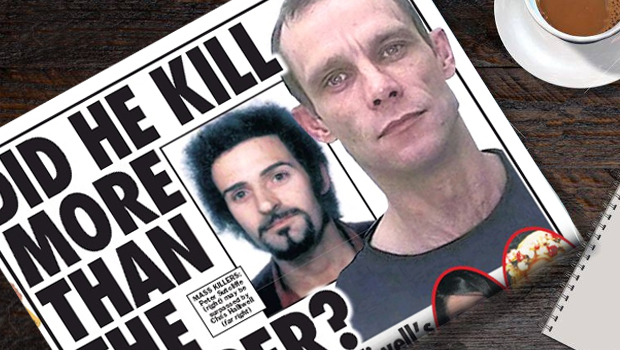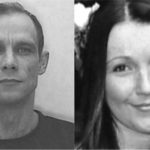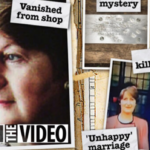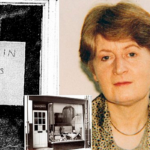Christopher Halliwell: How Many Victims?
by CHRIS CLARK & TIM HICKS
~~~~~
Introduction
This article is part of the NYE Christopher Halliwell Series:
- The breaking of Detective Superintendent Stephen Fulcher – by Tim Hicks
- Book review: “Catching a serial killer” by Stephen Fulcher – by Tim Hicks
- Christopher Halliwell and Peter Sutcliffe compared – by Chris Clark and Tim Hicks
- Christopher Halliwell: How many victims? – by Chris Clark & Tim Hicks
- Christopher Halliwell: The Secret Murders – By Chris Clark & Tim Hicks. Parts 1 – 6.
- Scotland
- Is Halliwell the “East Lancs Ripper”?
- The Middlesbrough and Northern Cases
- Christopher Halliwell: Did he murder Claudia?
- The Swindon area cases
- Outside Justice: Did Halliwell murder Linda Razzell?
In this fourth part of the series, Chris and Tim assess the police response to identifying the full extent of geographically mobile serial offenders. They then go on to indicate the potential numbers of victims that Halliwell could have, in addition to the two that have officially been attributed to him. New readers are urged to read the our article Christopher Halliwell and Peter Sutcliffe compared before starting this article.
The Police response to identifying the full extent of Sutcliffe and Halliwell’s offending
The authors contend that the Sutcliffe and Halliwell cases illustrate a serious failing in police procedures for investigating the wider range of offences committed by serial killers and other repetitive serial offenders. The police response to this aspect of the Yorkshire Ripper by West Yorkshire Police (WYP) and the investigations into Christopher Halliwell’s offending by Wiltshire Police have remarkable similarities and are characterised by:
Failure: WYP only identified two murders that Sutcliffe was responsible for but did not admit – although it is obvious – that there are many more. Wiltshire Police have not identified any further murders committed by Halliwell. The obvious source of linked evidence is the sixty items of women’s clothing found, together with a shotgun, in a pond at Ramsbury in May 2014. If this is his “trophy store”, the potential victims could be linked by showing the clothing to their next-of-kin and making potential DNA comparisons. Should an evidential link be found, it could help clear up some cases. However, so far as is known, Wiltshire Police has not identified the owner of any item of clothing recovered from the pond at Ramsbury.
Police ‘cap badge’ politics: It is in the nature of police officers to protect the reputation of their individual force no matter what. As an example, the WYP Yorkshire Ripper investigation was found to be fundamentally flawed. Yet Assistant Chief Constable Jim Hobson of WYP who led the investigation can be seen defending the investigation and describing the criticism of WYP as “ridiculous” here.
Understandably, WYP wants to move on from this investigative failure. However, any progress on the Yorkshire Ripper investigation now will inevitably encourage further criticism of the failure of the original investigation, further damaging the reputation of WYP. Likewise, any further murders that are attributed to Christopher Halliwell now, seven years after Detective Superintendent Fulcher arrested him, will further vindicate Fulcher’s actions. Leading to more criticism of Wiltshire Police over the way he was treated. NYE Report here.
There is an obvious conflict of interest in having officers investigating a case which will give rise to public criticism of their force, over a failed historical investigation.
Secrecy: The Byford, Samson and Hellawell assessments of how many murders and attempted murders Sutcliffe committed have never been released. In the case of Halliwell, Wiltshire Police released this statement to the NYE, which is clear that the ongoing investigation into Halliwell should not be commented on by the media:
“There has been much speculation in the press in relation to other women who may or may not have been a victim of Halliwell. This speculation is not helpful and is very distressing to the families involved. At this time, Wiltshire Police has not uncovered any links between Halliwell and any other murders across the country. We will undertake a proportionate investigation to establish whether Halliwell may have committed any further homicide offences – it would be inappropriate at this time to discuss specific cases.”
Bureaucratic intransigence: The Police are authority figures and do not like being challenged, criticised or shown to be in error. Accordingly there is a natural reluctance to cooperate with anything that will reveal failings, or open up the police to criticism or ridicule.
The NYE encountered this when our investigation into the notorious child abuser Peter Jaconelli, revealed he had openly abused children in Scarborough for thirty years in joint enterprise with Jimmy Savile, with the full knowledge of North Yorkshire Police. Assistant Chief Constable Sue Cross of North Yorkshire Police (NYP) issued a report to the Independent Police Complaints Commission stating that there was no evidence to back up the claims of the NYE, without bothering to interview any witnesses.
A BBC investigation then broadcasted the witnesses’ evidence and NYP was forced to admit that it had failed miserably to protect children in Scarborough.
In the Yorkshire Ripper investigation, the police wrongly convicted three men of a murder that was probably committed by Peter Sutcliffe. These were:
- Andrew Evans wrongly convicted of the murder of Judith Roberts in 1972 by Staffordshire Police.
- Stephen Downing wrongly convicted of the murder of Wendy Sewell in 1973 by Derbyshire Police.
- Anthony Steel wrongly convicted of the murder of Carol Wilkinson in 1977 by West Yorkshire Police.
It must be a cause of concern that in a number of murders that fit Halliwell’s MO, many men have been arrested but not charged and in one case -the disappearance of Linda Razell- a man is in prison for the offence.
The above statement from Wiltshire Police is a classic example of bureaucratic intransigence. It says basically, investigations by journalists should not take place, there is no evidence to indicate any connection to any unsolved crime or that anything has gone wrong and Wiltshire Police is not going to discuss it any further.
Budgetary constraints: Sutcliffe and Halliwell are both in prison for full life terms and will never be released. Fulcher was scathing about the way that Operation Mayan was run down as soon as Halliwell was arrested and the reluctance of Chief Officers to pursue investigations into other offences he may have committed. This may be due to an understandable reluctance by Wiltshire Police to expend resources on an investigation into offences which will not add to the sentence of the offender, because he is imprisoned for a full life term. It may also be because of reluctance by Wiltshire Police to expend its resources on an investigation into offences that are recorded as unsolved on the books of another force.
Failure of the centralised oversight function: Nowadays the National Police Chiefs Council co-ordinates the activity of police forces. Accordingly I wrote to the Chair of the National Police Chiefs Council Chief Constable Sara Thornton, raising my concerns on this issue:
Chief Constable Sara Thornton QPM, CBE,
Chair of the National Police Chief’s Council,
1st Floor, 10 Victoria Street,
London SW1H 0NN
Dear Chief Constable Thornton,
Police policy on assessment of the full range of crimes committed by a convicted serial offender
I am an investigative journalist and I am writing in connection with police policy on the investigation of unsolved crimes, which may have been perpetrated by a convicted serial offender, but who will not reveal the full extent of his offending.
I have recently co-authored an article with a retired police intelligence officer, concerning the full extent of the offending of Peter Sutcliffe. It contains what is in my belief the most comprehensive estimate of the extent of Sutcliffe’s offending that is available in the public domain.
Yorkshire Ripper how many victims?
In the article, I argue that there is insufficient guidance or national policy available to detectives on when to attribute a crime to a serial offender. Thereby leaving the case unsolved and open indefinitely, and denying the victims closure. I also argue that in the specific case of Sutcliffe, the case has not been subjected to a national review by a force that was not involved in the original investigation. I believe that such a review could resolve some of these offences.
I appreciate that the police must always have a concern that no information should be made public that could prejudice a future criminal investigation or an ongoing judicial process into a case that is currently unsolved. Accordingly they are understandably reluctant to release information on cases such as those specified above. However, this has the unfortunate consequence of preventing closure for the victims of crimes. There is no national guidance or policy from the College of Policing or the National Police Chief’s Council on how to assess the full range of a convicted serial offender’s crime. In my view this is a major omission. As a result, individual forces appear to be following a blanket national rule of not commenting on any case that -on the available evidence- appears to have been committed by a serial offender, but for which they do not have sufficient evidence to send to the CPS. There is a lack of standardisation of method and policy, in conducting this aspect of an investigation into a serial offender. Nor in my belief is there sufficient central oversight and review of the conduct of this aspect of an investigation.
There are some exceptions to this rule:
- Harold Shipman was convicted of fifteen murders. But an enquiry by Her Honour Judge Dame Janet Smith was convened to assess how many murders he actually committed. It identified that he had murdered 250 of his patients.
- At the conclusion of Operation Hibiscus (in which I participated), North Yorkshire Police issued a statement that if Peter Jaconelli and Jimmy Savile had been alive a file would have been passed to the CPS in connection with thirty serious offences.
- At the conclusion of Operation Conifer (in which I participated), Wiltshire Police issued a statement that if Sir Edward Heath had still been alive he would have been interviewed under caution.
I would like to ask that the NPCC consider issuing guidance on when it is appropriate to issue an assessment of further crimes that may have been committed by a convicted serial offender, to give closure to the victims.
I would also ask that because of the number of victims and the importance of the case, the NPCC consider ordering a national review of the Sutcliffe case. This is to obtain some form of resolution of the issue of his potential involvement in many unsolved crimes and to obtain some form of closure for the victims.
I thank you in anticipation of your consideration of these two suggestions and look forward to your response in due course.
Yours faithfully,
Tim Hicks
Chief Constable Thornton did not bother to respond.

Chief Constable Sara Thornton
Not commenting on the issue of the ongoing police failure to fully investigate serial offenders.
The investigation into Yorkshire Ripper by West Yorkshire Police (WYP) was itself reviewed by Sir Lawrence Byford of HM Inspectorate of Constabulary. It followed the “Black Panther” investigation (documentary here). Which was another high profile, multi force investigation that failed because individual police forces were not centrally co-ordinated. Sir Lawrence Byford concluded:
“Regretfully, some of these lessons were previously identified at the conclusion of the “Black Panther” case in 1975 but, in the light of the Ripper case, quite clearly the Police Service has not learned from them, particularly those relating to the management and control of a multi-force murder investigation.”
“We feel it is improbable that the crimes in respect of which Sutcliffe has been charged and convicted are the only ones attributable to him. This feeling reinforced by examining the details of a number of assaults on women since 1969 which in some ways, clearly fall into the established pattern of Sutcliffe’s overall modus operandi…”
“It is my firm conclusion that between 1969 and 1980 Sutcliffe was probably responsible for many attacks on women, which he has not admitted, not only in West Yorkshire and Manchester but also in other parts of the country….”
NYE Article on Sir Lawrence Byford and his investigation here.
These words are just as applicable to Christopher Halliwell today as they were to Peter Sutcliffe in 1981. It appears that nothing has changed and the police are not able to impartially investigate geographically mobile serial offenders.
Failure to consider the victim’s families: The Wiltshire Police statement above asserts the position that media comment on Halliwell’s victims’ causes distress to victims’ families:
There has been much speculation in the press in relation to other women who may or may not have been a victim of Halliwell. This speculation is not helpful and is very distressing to the families involved.
The primary concern of the victim’s families is to see progress on the investigation into their loved ones murder or disappearance. It should be said that the ongoing failure by the police to make progress is also causing distress to the families, some of whom have complained about police stonewalling them and a lack of interest in investigating the crime.
Media comment on this topic is in the context of an investigation that has been running since 2011 and which has not resolved any offence. In this context it is right for the media to start asking questions and holding the police to account for this failure. Hence perhaps the Wiltshire Police statement discouraging media attention.
Potentially how many victims?
Halliwell indicated in a telephone call that was monitored from prison that the police wanted to interview him about eight murders. Although Wiltshire Police were at that time only investigating him in connection with two. This immediately indicated that Halliwell had committed in fact eight murders, in addition to Miss O’Callaghan and Miss Godden-Edwards.
In the book, Fulcher asserts that four of the missing six victims are:
- Sally Anne John.
- Melanie Hall.
- Claudia Lawrence.
- Linda Razell.
In correspondence with Chris, Fulcher has identified the other two persons he believes Halliwell was referring to in this conversation as:
- Thi Hi Nquyen.
- Sandra Brewin.
More evidence has emerged since Halliwell’s remarks in the monitored call:
- In May 2014 Wiltshire Police found a cache of property in and around an eight foot deep pond in woodland in Ramsbury, Wiltshire. It comprised a shotgun and sixty items of women’s clothing including a pair of boots that belonged to Miss O’Callaghan and a cardigan that belonged to Miss Godden-Edwards. It is suspected that this may be a “trophy store” and a place Halliwell visited to obtain perverse sexual gratification from his knowledge of the items concealed there.
- A pair of knickers was recovered from Halliwell’s garage shortly after his arrest, which did not belong to his partner or his daughters. This took on more significance with the discovery of the cache of clothes at Ramsbury.
On the basis that the “trophy store” at Ramsbury contained sixty items of women’s clothing of which one set/item was a pair of Miss O’Callaghan’s boots and one item was Miss Godden Edwards’s cardigan, it could be that Halliwell’s practice was to store one set/item per victim there. If this is so, then it means that the remaining fifty seven items at Ramsbury could be from up to fifty seven individual victims.
Further, if the unidentified knickers found in Halliwell’s garage are a trophy, he could have been about to deposit them in the pond in Ramsbury when he was arrested. If so, then it means that he had another victim, potentially making fifty eight persons he had retained a trophy for.
Every year thousands of people are reported missing in the UK. Including many missing from Swindon and the South West. Many more are missing but not reported as such. Miss Godden-Edwards was one of them. How many of them are murder victims, whose disappearance is completely unknown to the police?
As this 2010 Independent on Sunday article makes clear, the police were not successful at investigating prostitute murders at the time. In this context, it should be remembered that Halliwell targeted prostitutes, many of whom lead itinerant lives, shun the police and are not missed if they disappear. How many murdered/disappeared sex workers were his victims?.
Halliwell’s career as a serial killer could have started in his late teens or early twenties. Both lead detectives on the investigation into Halliwell (Detective Superintendent Fulcher and Detective Superintendent Memory) confirmed Halliwell was interested in becoming a serial killer in at least 1985. It is credible that he started murdering earlier than his imprisonment in 1985 when he was twenty one. He was forty seven when he was arrested. He was forensically aware and a skilled criminal, so it is quite conceivable that he could have been killing multiple victims a year for all of that period without detection.
Peter Sutcliffe was confirmed to have committed twenty six murders or attempted murders and the authors assert that in total he committed fifty nine that we can identify. See Table 1 and Table 3 in the article Yorkshire Ripper: How many victims?
Far-fetched? Please see this documentary on Serial Killer Peter Tobin from 47 minutes onward. The much respected psychologist Professor of Criminology David Wilson, who has interviewed many serial killers estimates that although Tobin was convicted of three murders, he had been actively killing for “decades” and his first murder was in 1968. Tobin claimed in prison that he had murdered forty eight people. Between 1968 and his first life sentence in 2007, Tobin served ten years in prison, meaning he was at large for twenty nine years. At two victims a year, a total of forty eight victims is entirely credible, of which only three have been resolved by the police.
Chronological profiling of Halliwell
Chris has assessed the murders against Halliwell on the basis of his known Modus Operandi and geographical links.
“I have catalogued a series of unsolved murders and reports of missing women which seem to fit the elements of Halliwell’s two murder convictions. Picking up on the narrow boat holidays and fishing trips which Halliwell was an enthusiast of, as were his residences and employment around the country I looked at a number of cases which appear to have links with the various Canals and Waterways throughout England and Scotland. I researched them in chronological order following Halliwell’s release from prison in 1987.”
To do this, Chris used a technique he has developed called “Chronological Profiling” first used in his book “The Face of Evil. The true story of serial killer Robert Black”. The offender is assessed in terms of the number of times he attacks or kills and the frequency of these events on a timeline, examining any potential gaps and then seeing if there are any offences that fit the offenders “modus operandi” and location which can fill in the gaps in the timeline.
His conclusions are shown in tabular form below, along with a chronology of Halliwell’s life.
Until this present article, no national assessment of offences Halliwell may have committed has ever been issued. The authors believe that this is the most accurate and credible overall assessment of Halliwell’s offending nationally that is currently available in the public domain. However:
- It is possible that some cases will be eliminated by the police on the basis of evidence not available to the authors.
- Chris’s research was focussed on offences committed close to canals and waterways, or where the deposition site was close to one. There will undoubtedly be other offences committed in a vehicle which were not located near a canal, river, lake or waterway.
- Chris has identified a further twenty seven murders and disappearances that Halliwell should be considered a suspect for. Based on the recovery of sixty items of women’s clothing from the pond in Ramsbury and the analysis of the time Halliwell could have been offending for above, there could conceivably be a lot more.
- As the investigation progresses and more evidence becomes available, new cases will be added. One case was added during the preparation of this article.
The authors believe that the full extent of Halliwell’s offending nationally can only be identified and assessed by a centralised investigation.
In the forthcoming article in the series, “Christopher Halliwell: The Secret Murders”, the authors will present the case for considering Halliwell as a suspect in each of the individual cases specified in Table 1 above, in six articles in the Christopher Halliwell series.













